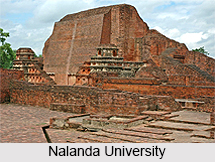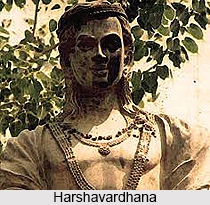 The glory and progress of Nalanda had reached its climax during the reign of Harshavardhana.
The glory and progress of Nalanda had reached its climax during the reign of Harshavardhana.
Harshavardhana had also donated a lot of money to Nalanda for its development. Harshavardhana also made matchless donation to Nalanda. One of his gifts to this university consisted in the construction of a magnificent temple covered with brass plates by the side of the principal monastery, about one hundred feet in height.
Naming of Nalanda
The ancient name of this university was `Nal` which was situated at a place called Baragaon in Bihar. In the course of time many Buddhist viharas were built there. In fact, it was built by Ashoka but the work of teaching started long after Ashoka`s death. It had already become famous during, fourth and fifth century A.D. Most of the scholars agree its rise had taken place after the visit of the Chinese traveller, Fahien.
Progress before Harshavardhana
When Hiuen Tsang visited India, Nalanda had already made a great progress. During the visit of Hiuen Tsang, Nalanda was comprised of a group of six monasteries, five of which were constructed by Gupta kings and one by a king of Madhya Pradesh. The latter was probably Harshavardhan. Besides monasteries, there established many other things. According to the Chinese Traveller, Itsing, who came to India in the 7th century A.D. there was eight alayas and there were hundred rooms. The buildings of Nalanda were excellent from the point of view of architecture and sculpture. Historians opine that it`s brickwork; the structure, is amazingly far superior to any modern work.
 Development of Nalanda during the rule of Harshavardhana
Development of Nalanda during the rule of Harshavardhana
It can be learnt from the description of Hiuen Tsang that Harshavardhana had donated hundred villages to Nalanda. It is said that about 10,000 students were on the rolls of the university. The students from China, Mongolia, Korea, Tibet, etc., came to study here. There was a very hard test for admission into the university. According to Hiuen Tsang, only 20% of the students were declared successful in the examination. There were 1,570 teachers in Nalanda, 10 of which were regarded as the best available in that period. The teaching of Buddhist religion was performed with great ability and sincerity. According to historians, it was at that time the most celebrated seat of learning, and pride of the Buddhist world. Besides Buddhist religion, literature, medical science, linguistics etc. were also taught in great vigour.
Atmosphere of Nalanad during Harshavardhana"s Rule
The atmosphere of Nalanda was very peaceful and conducive to the study of different subjects. Yuan Chwang writes, "Learning and discussing, they found the day too short; day and night they admonished each other; juniors and seniors helping to perfection."
The special attention was given to the discipline of the students and a high standard of the discipline was maintained. As remarked by a scholar, "The students of Nalanda were looked upon as models by all India."
Faculty of Nalanda
There was a big library known as `Dharmayayogya` in the Nalanda University. A scholar named Shilabhadra was the Vice-Chancellor. Before Shilabhadra, Dharampala was the vice-chancellor of Nalanda University. Under the chancellor, there used to be a Viharaddyaksha. Scholars of different subjects lived in the university. Among the able teachers of Nalanda University the names of Shilabhadra, Dharmapala, Gunamati, Chandrapala, Sthriman, Gyan Chandra, Kamal-shila etc., are most prominent.



















